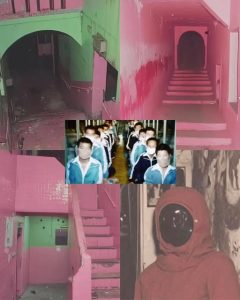Before Squid Game became a global sensation, captivating viewers with its brutal survival games and haunting social commentary, whispers circulated about a far darker origin. While the Netflix series is officially labeled as fiction, many claim it drew eerie inspiration from a chilling and little-known incident buried in South Korea’s shadowy past.
In the spring of 1986, during a tense period marked by political unrest and Cold War paranoia, a peculiar event reportedly took place in a disputed area between the North and South Korean borders—an isolated zone colloquially known as “no man’s land.” Nestled beneath a now-collapsed structure near the DMZ was a hidden underground bunker. According to declassified military documents and hushed eyewitness accounts that surfaced years later, this site became the stage for a horrific ordeal that still remains largely unsolved.

The story goes that a group of civilians—ranging from factory workers to university students—were abducted from various cities across South Korea and transported to the mysterious bunker under unknown circumstances. The details of how they were lured or captured remain murky, but what happened next is the stuff of nightmares.
Trapped inside the labyrinthine bunker, the captives were reportedly forced to compete in a series of bizarre and dangerous games. These weren’t simple tests of skill or luck. They were deadly contests, rigged with high stakes and brutal consequences. Failure meant death. Winning, it seemed, only guaranteed another round. Each game mirrored children’s playground activities, twisted into macabre versions of themselves. Sound familiar?
Survivors—only two are believed to have made it out—later described a faceless figure orchestrating the events from behind a darkened screen. This “host” never revealed their identity and communicated only through distorted speakers. Their motives? Unknown. Some speculated it was part of a deranged psychological experiment, possibly orchestrated by a rogue faction within the military or an underground cult. Others believed it was a high-stakes form of illegal entertainment for the ultra-rich, eerily paralleling the elite spectators in Squid Game.
Despite multiple investigations, no perpetrator was ever apprehended. The site was demolished in the late ’80s, and the incident faded into obscurity—dismissed by many as conspiracy or myth. Yet those who believe remain convinced: this gruesome tale was real, and it planted the seeds for the fictional world that would later captivate audiences worldwide.
While creator Hwang Dong-hyuk has cited various sources of inspiration for Squid Game—such as the disparity in Korean economic class and his own personal struggles—rumors of the 1986 bunker event have persisted among internet forums and urban legend circles for years. Whether fact, fiction, or a twisted blend of both, the parallels are undeniably unsettling.
It serves as a reminder that sometimes, the most disturbing stories come not from imagination, but from history’s forgotten corners—where truth blurs into horror, and the games we play reveal the darkest parts of human nature.



